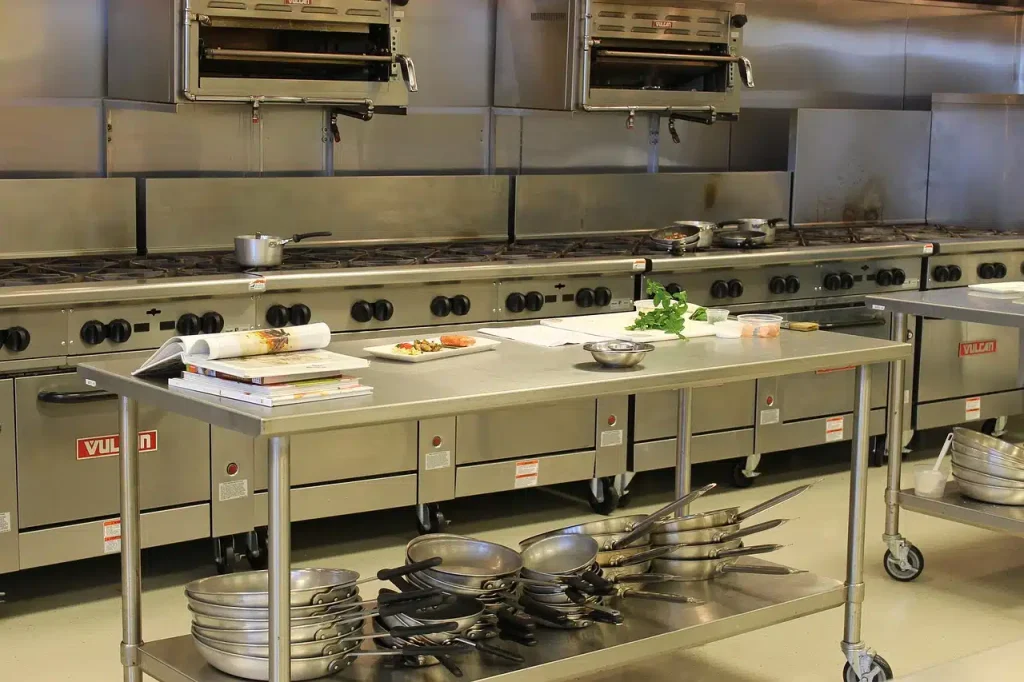
Source: https://unsplash.com/photos/kitchen-interior-bn4Ve3NjQ8g
You know that feeling when you’re rushing to pack school lunches, and you can’t find the lids to your containers? Or when you’re trying to start dinner after a long day, but your counters are so cluttered you don’t even have space to chop an onion?
If you’re nodding along, you’re not alone. Most busy households struggle with kitchen organization, and it’s not because we’re lazy or don’t care. It’s because life happens fast, and our kitchens often can’t keep up with the pace. But here’s the good news: with some simple strategies, you can transform your kitchen from chaotic to calm. You don’t need a complete renovation or a massive budget. You just need a plan that actually works for real life.
Identifying Problem Areas in Your Kitchen

Source: https://unsplash.com/photos/a-kitchen-with-a-stove-top-oven-sitting-next-to-a-counter-2LUcwnyH0-w
Recognizing Common Clutter Hotspots
Let’s start by being honest about where things go wrong. Walk into your kitchen right now and look around. What do you see?
For most of us, the countertops are covered with small appliances we use once a month, random mail, kids’ artwork, and that bag of chips we swore we’d put away. The junk drawer is overflowing with takeout menus, batteries, and mystery keys. Your pantry probably has canned goods from two years ago hiding behind newer purchases. And don’t even get me started on those cabinets where avalanches of Tupperware tumble out every time you open the door.
The refrigerator? Let’s just say there are leftovers in there you’ve forgotten about, and you’re buying duplicates because you can’t see what you already have.
Understanding Root Causes of Disorganization
These problems happen for a reason. Usually, it’s because items don’t have designated homes. When something doesn’t have a specific spot, it ends up wherever there’s space at that moment. Over time, this creates chaos.
Another issue is that we’re not using our vertical space effectively. We pile things on top of each other instead of stacking them properly. This is where tools like a quality shelf organiser come in handy. They help you maximize your existing storage by creating additional layers and keeping similar items together. When you can actually see what you have, you’re less likely to overbuy and more likely to use what’s already there.
The truth is, most kitchens have enough storage space. We’re just not using it strategically.
Building a Foundation for Lasting Organization
The Decluttering Phase
Before you buy anything new or reorganize, you need to declutter. I know, I know. It’s not the fun part. But it’s essential.
Go through your kitchen and sort items into three piles: keep, donate, and toss. Be brutally honest with yourself. That bread maker you used once three years ago? Someone else could be using it. Those chipped mugs you keep “just in case”? Let them go. Check expiration dates on everything, including spices. Yes, spices expire.
Remove duplicate tools. You don’t need five wooden spoons or three can openers. Keep your favorites and donate the rest.
Strategic Space Allocation
Now that you’ve cleared out the excess, it’s time to be smart about what stays and where it lives.
Give your prime real estate to the items you use every day. Coffee mugs should be near the coffee maker. Cooking oils and frequently used spices should be within arm’s reach of the stove. Breakfast items should all live together so your morning routine flows smoothly.
Store specialty items like your fondue set or holiday cookie cutters in less accessible spots. High cabinets or back corners are perfect for things you only use occasionally.
Create landing zones for everyday items that tend to clutter up your space. Keys, phones, and wallets need a designated spot near the door. School papers and permission slips need a command center. When everything has a home, it’s easier to keep things tidy.
Designing Zones That Support Your Routine
Activity-Based Organization
Think about how you actually use your kitchen. Most of us move through predictable patterns, so let’s design around those habits.
Create a morning routine station with everything you need for breakfast. Coffee, tea, cereal, bread, and breakfast dishes should all be in one area. This way, even on chaotic mornings, everyone knows exactly where to go.
Set up a meal prep zone with cutting boards, knives, and mixing bowls near your main workspace. Keep your cooking zone around the stove with oils, spices, and utensils within easy reach.
A beverage station with mugs, glasses, and drink supplies keeps people from rummaging through multiple cabinets. And here’s a game-changer: create a snack zone that’s accessible for kids. When they can help themselves, you field fewer requests and they build independence.
Family-Friendly Accessibility
Speaking of kids, design your organization with the whole family in mind. Put children’s dishes, cups, and snacks at heights they can reach. This isn’t just about helping them be independent. It’s about reducing the number of times you have to stop what you’re doing to get someone a cup.
Use clear containers and label them with pictures for younger kids who can’t read yet. Assign specific cabinets to different family members. When everyone knows where their stuff belongs, there’s less confusion and fewer arguments.
Install hooks at varying heights for aprons, dish towels, and reusable bags. Make it easy for everyone to pitch in.
Maximizing Every Inch of Available Space
Vertical Storage Solutions
Most of us only use about half of our available kitchen space because we forget to look up. Your walls, the insides of cabinet doors, and the space between shelves are all valuable real estate.
Hang pots and pans on wall-mounted racks to free up cabinet space. Use stackable containers in your pantry so you can see everything at a glance. Add under-shelf baskets to create extra layers inside cabinets. Install a magnetic strip on the wall for knife storage.
The backs of cabinet doors are perfect for hanging measuring cups, pot lids, or cleaning supplies. These small additions make a huge difference in how much you can store.
Hidden Storage Opportunities
Get creative with overlooked spaces. If you have deep cabinets, use pull-out organizers so items in the back don’t become black holes. Corner cabinets are notorious for wasted space, but lazy susans or corner drawer systems solve that problem.
Look for narrow gaps between appliances where you could slide in a rolling cart. Use drawer dividers to keep utensils organized instead of jumbled together. Even the toe-kick area beneath your cabinets can be retrofitted with slim drawers for flat items like baking sheets.
Maintaining Systems in Real Life
Daily Habits for Busy Families
Organization isn’t a one-time project. It’s an ongoing practice. But don’t worry, maintenance is much easier than the initial setup.
Get in the habit of doing a quick kitchen reset each evening. Load the dishwasher, wipe down counters, and put ingredients back where they belong. This takes maybe ten minutes but ensures you wake up to a clean slate.
Try to clean as you go when you cook. Wipe up spills immediately, put ingredients away after you use them, and load prep dishes into the dishwasher while food is cooking.
Sustainable Long-Term Practices
Schedule a monthly pantry audit. Check for expired items, reorganize shelves, and make a note of what you’re running low on before your next grocery run.
Involve your whole family in maintenance. Assign age-appropriate tasks to kids. Even young children can put their dishes in the sink or wipe down the table. When everyone contributes, the burden doesn’t fall on one person.
Be willing to adjust your systems when they stop working. Maybe the snack zone needs to move, or you need different containers. That’s okay. Your organization should serve you, not the other way around.
Conclusion
Perfect organization doesn’t exist, and that’s completely fine. The goal isn’t to have a kitchen that looks like a magazine spread. It’s to create functional systems that save you time, reduce stress, and make daily life smoother.
Start small. Pick one drawer or cabinet and organize just that space. Success builds momentum, and before you know it, you’ll have tackled the whole kitchen.
Remember, an organized kitchen isn’t about impressing anyone. It’s about giving yourself the gift of a calm, efficient space where you can actually enjoy cooking and spending time with your family. You deserve that.
FAQs
Q: How long does it take to fully organize a kitchen?
A: The initial deep organization typically takes a full day to a weekend, depending on your kitchen size and how much decluttering is needed. But once your systems are in place, daily maintenance only takes about five to ten minutes.
Q: What should I do with items I rarely use but can’t part with?
A: Store seasonal or special occasion items in less accessible spots like high cabinets, the garage, or basement. Reserve your prime kitchen space for everyday essentials. If you haven’t used something in over a year, seriously consider whether you need to keep it.
Q: How can I get my family to maintain the organization?
A: Make it easy and intuitive. Use clear labels, involve everyone in creating the systems, and assign specific responsibilities. When family members help design the organization, they’re more invested in maintaining it. Praise efforts and be patient with the adjustment period.
Q: Do I really need to buy expensive organizing products?
A: Not at all. Start with free solutions like shoe boxes, mason jars, and repurposed containers. Once you see what works, then invest in quality products for high-traffic areas. Focus your budget on solutions that address your biggest frustrations first.
